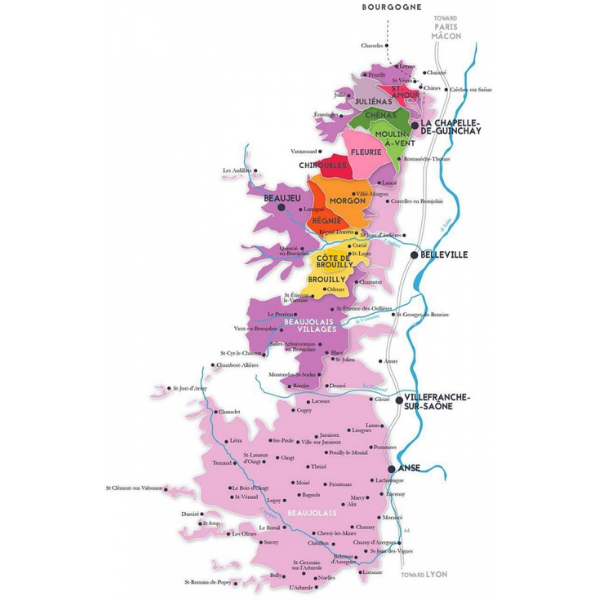“BEAUJOLAIS” – THE UNDERESTIMATED NEIGHBOUR OF BURGUNDIA

The Beaujolais appelation, unfortunately was and still is identical with fruity, fresh and “festive” wines, which are distributed annually the third Thursday of November, and are intended exclusively for immediate consumption, and I use the word unfortunately, because Beaujolais is capable of producing more superior and quality wines.
The majority of Beaujolais wines are produced with the so called semi-carbonic maceration, which gives wines with intense fruity character and few and discreet tannins. Nowadays things seem to change, and we see more producers to “walk the road”, in an attempt to produce wines with fuller body and better ageing potentials. One of the reasons of this change is that the Nouveau trend is out of fashion and sales have a noticeable drop.
The area is located between the cities of Macon and Lyon and is divided in two by the Nizerand river. In the northern part, granite soils dominate with Gamay (Gamay Noir à Jus Blanc) starring, covering almost 98% of the plantings and is expressed better by giving excellent wines under the Cru Beaujolais and Beaujolais Villages appellation, while on the southern part we come across much lighter and simpler versions of Beaujolais.
Let’s have a quick look at the Crus of Beaujolais, which are ten. The first five (Chiroubles, Chenas, Morgon, Moulin-a-Vent and Fleurie) have AOC classification since September 1936.Saint-Amour, the northernmost Cru of Beaujolais, where some white wines are vinified, which are distributed as Beaujolais Blanc or St.-Veran, because of the limestone soils which can be found on the part meeting Burgundy. After that comes Juliénas, which is said to have been named after Julius Cesar and the quality of the wines produced have big quality deviations. Walking south, we come across a smaller Cru of Beaujolais, called Chénas, with wines worth searching for but hard to find. Right after that is the “King of Crus”, Moulin-à-Vent, which means windmill kai produces wines with very nice concentration and great ageing potential. Next is Fleurie, with wines characterized by floral aromas of roses and violet. Even further south Chiroubles is located, in a higher altitude which makes the wines lighter and ideal for the transition of consumers familiar with Beaujolais through the Nouveau version. The next Cru while descending is Morgon, the second largest, produces bolder wines with great ageing potential similar to the “King of Crus” we met before. It’s worth mentioning the fact that in this Cru includes the famous vineyard Côte de Py. The most recent addition was in 1988 when Régnié was upgraded, without the wines produced being able to reach their neighbour’s level, besides some bright exceptions. Reaching the end, we come across Côte de Brouilly and Brouilly, the largest and southernmost of Crus.
Summarizing, we have to mention the important influence of the four winemakers of the region (Jean-Paul Thevenet, Guy Breton, Jean Foillard and Marcel Lapierre), who in the 8o’s focused in producing high quality wines from old vines, following organic and biodynamic cultivation with minimum sulfite usage. This style of wines “gain ground” abroad because of affordable pricing, excellent quality and the new trend of natural wines
It is about time to see Beaujolais wines from another perspective…

